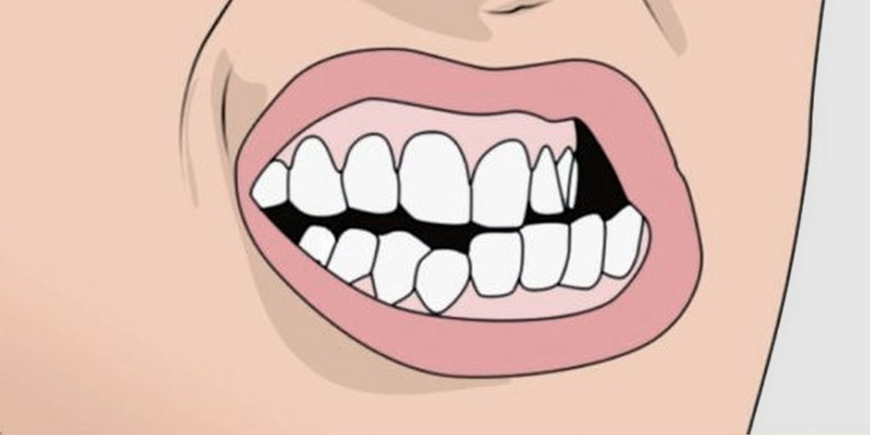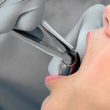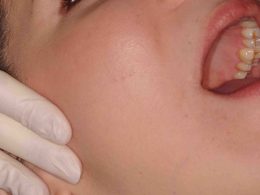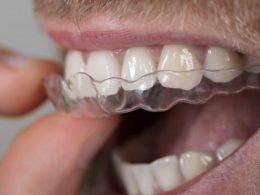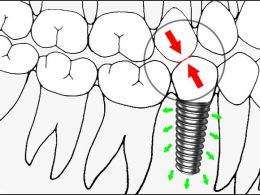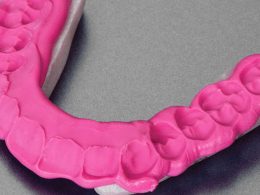Table of Contents
The temporomandibular joint (TMJ) is the one that relates the mandible to the skull. It allows the opening and closing of the mouth, in addition to all the movements that are made when speaking, eating and gesturing. It is a joint similar to that of other parts of the body, consisting of a meniscus, two articular surfaces and a series of ligaments.
When the teeth are not properly aligned and arranged in the arches, when closing the mouth the mandible does not fit properly with the upper jaw, forcing it to deviate its trajectory to achieve a better gear or accommodation. This postural habit causes fatigue and spasms of the masticatory muscles, and these in turn, overload and disrupt the normal functioning of the ligaments and temporomandibular joints.
Thus, with the passage of time, pains appear in the facial region and noticeable noises in the joints when opening and closing the mouth. When this happens, we speak then of a masticatory dysfunction or occlusal disease, or popularly, “bad bite”.
At the same time, occlusal disease can be a cause or consequence of bruxism. Bruxism or dental clenching is the most frequent harmful activity for the masticatory system. It is a deeply ingrained habit in modern society, related to situations of emotional tension or stress, anxiety and small daily frustrations. It is more frequent to manifest itself during sleep, once the alert mechanisms have disappeared. This fact prevents us from being aware of it.
There are also another series of factors that can also favor the appearance of this type of dysfunction, such as: the displacement of the teeth towards the spaces left by tooth extractions or losses when they are not replaced as soon as possible, poorly fitted prostheses, iatrogenic dental treatments and some frequent habits.
Among them, the habit of biting the nails (onychophagia), compulsive chewing of bubble gum, the custom of biting seeds and the mania of chewing on the lips or cheeks; are also behaviors capable of altering the occlusal balance.
However, it is usual for a masticatory dysfunction to start and progress, several of the factors described are combined at the same time. The result can be the appearance of injuries in the temporomandibular joints that will give rise to clicking, pain and occasionally blocking of the same.
Below we will describe the main signs and symptoms of occlusal disease, so that you are always attentive and can demand an early diagnosis from your Dentist, or at least, a referral to the most indicated Specialist.
Signs and Symptoms of Occlusal Disease
Assessing whether the patient has a “bad bite” is much simpler than most people think. If the person presents one or more of the eight signs and symptoms that we will describe below, we should suspect the existence of a pathological occlusion, and therefore, spend time studying the case to corroborate or rule out the dysfunction.
The eight main signs and symptoms that characterize occlusal disease are:
1- Pathological Occlusal Wear and Frequent Teeth and Restorations Fractures
Almost anyone can detect pathological tooth wear almost immediately. Occlusal wear is multifactorial, a combination of functional friction, erosion, and abrasion. People who observe excessive wear on their teeth, must always infer that their bite is not correct. The same if their teeth are chipped or broken frequently or the amalgams or composites that their Dentist make him fall easily.
2- Cervical Dentin Hypersensitivity
Some may be surprised to learn that many cases of dental hypersensitivity are caused by occlusal trauma, and that bite adjustment is undoubtedly the most indicated treatment modality to eliminate it.
Unfortunately this is unknown to many Dentists, who try other treatments without success to resolve the discomfort. They place fluoride, varnishes, sealants, restorations and even do root canal treatments; without noticing that the problem is in the bite.
If you suffer from dental hypersensitivity for no apparent reason or if all your Dentist’s efforts to eliminate it have failed, it is very likely that you have some form of occlusal disease.
3- Tooth Hypermobility
If you ever feel that your teeth move and loosen, you most likely have periodontitis or periodontal disease. However, there are cases in which the teeth are highly mobile despite not having lost the bone that supports them.
In these circumstances the correct thing is for the Dentist to indicate a radiographic study to be able to evaluate the supporting tissues and make a differential diagnosis. If by chance your Dentist considers the possibility of extracting teeth with severe mobility right away, suggest that he first study the case and rule out occlusal trauma, since if it is the cause, the prognosis is good; and the teeth can be stabilized after treatment.
4- Dental Fremitus
The dental fremitus is a vibration or small mobility that is felt in the anterior teeth when patients bite naturally, in maximum intercuspation. This mobility has long-term negative effects such as the separation or proclination of the anterior teeth, and possibly, bone loss of its supporting bone.
Pathological occlusion is often the culprit for anterior teeth fremitus, a condition that seriously threatens their health and permanence in the mouth. Similar to hypermobility, fremitus is also a sign of occlusal disease.
5- Abfractions
Abfraction is a form of non-carious dental tissue loss that occurs along the gingival margin. In other words, abfraction is a mechanical loss of tooth structure that is not caused by decay, located along the gum line.
The tooth tissue gradually weakens in this area causing the loss of structure through chipping, fractures and successive wear; leaving a non-carious lesion on the surface of the tooth. These lesions affect both the dentin and the enamel of the tooth.
When detecting this type of injury, the professional must always rule out an occlusal etiology.
6- Vertical Bone Loss and Localized Bone Destruction Secondary to Periodontal Disease
Vertical bone loss or localized bone destruction is another sign of masticatory dysfunction. The literature clearly demonstrates that tooth mobility accelerates bone loss in patients with periodontal involvement. Therefore, a radiographic series showing generalized periodontal disease with accelerated bone loss in very specific areas, can be a suggestive sign of occlusal trauma.
7- Pain and Spasms of the Facial and Masticatory Muscles
This symptom and the next, have been intentionally placed in the last two places, and not because they are less important than the previous ones, but because the other six symptoms are overlooked with much more frequency.
Most Dentists quickly associate joint and facial muscle pain with occlusion problems, and they do so for good reason. Hypertonic facial and masticatory muscles, which can also often trigger headaches, are a frequent cause of pain; but patients rarely report these symptoms to their Dentist because they think they are not related to Dentistry.
If this is your case and you have gone to the Doctor several times without finding a solution to the problem, discuss it with your Dentist, since a malocclusion could be the origin of the headaches.
8- Pain and Noises at the Temporomandibular Joint (TMJ)
The “bad bite” causes hypertonicity and functional imbalances in the masticatory muscles, and these in turn, causes the ligaments that control the movement of the articular meniscus to function incorrectly and asynchronously. In this way, the meniscus is advanced or delayed in relation to the displacement of the mandibular condyle, which forces it to suddenly jump to regain its position. This is when the click or snap occurs.
The pain is produced by overcompression, accumulation of excessive loads and inflammation of the various intracapsular components of the joint.
Importance of Early Diagnosis
Occlusal disease, if left untreated, becomes a chronic destructive process that can affect all parts of the masticatory apparatus; mainly teeth, muscles and joints.
If a simple or incipient masticatory dysfunction is not detected and treated on time, it can evolve and become a true temporomandibular disorder. In extreme cases, this pathology could lead to total wear of the crowns of the teeth, the articular meniscus and the mandibular condyle; generating osteoarthritis at the level of the temporomandibular joint (TMJ).
Osteoarthritis at that level represents a very painful, severe degenerative phenomenon that forever prevents the mandibular movement (the person can no longer open his mouth). In these cases, to regain function, the patient must undergo large maxillofacial surgeries to reconstruct the joint with autologous grafts and alloplastic prostheses.
An early diagnosis of masticatory dysfunction will preserve the health of your teeth, gums, muscles and joints; it will save you a lot of hassle, major surgeries, and a lot of money.
Treatment of “Bad Bite”
Many authors consider that masticatory dysfunction cannot be cured, but it can be treated and controlled with adequate occlusal therapy. Although the scope of this post cannot include an extensive discussion of the various treatment options, the most important thing to know is that after identifying any of the eight signs and symptoms listed above, the practitioner must confirm the diagnosis and take sufficient time to explain to the patient all the implications of his dysfunction.
The diagnosis involves a thorough clinical evaluation, the practice of radiographic studies including tomographies and magnetic resonances, and of course, an occlusion analysis with the help of adjustable articulators.
Education is the main factor to achieve treatment acceptance and clinical success, for interceptive, functional and/or aesthetic treatment; since the collaboration of the patient is essential in this type of pathology.
The most common initial therapy would be a night guard as a preventive measure, to slow down the damage caused by the dysfunction. The definitive treatment includes the use of mandibular repositioning splints, occlusal adjustment by selective grinding and orthodontic and/or oral rehabilitation with fixed prosthodontics procedures in the most severe cases.
“It Is Very Common that the First Manifestations of the Masticatory Dysfunction Go Unnoticed, Both for the Patient and for the Professional”.
DENTAL TIP
Be Part of the Solution and Not the Problem…
Occlusal disease is often not diagnosed early, although Dentists treat its effects almost daily. Masticatory dysfunction is destructive, impairs the normal functioning of the stomatognathic system, and its treatment in advanced stages is costly for the patient.
Dentists should implement screening for these types of problems in their daily routine of examinations, however, it is something that generally does not happen. But now, you know the 8 main signs and symptoms of “bad bite”, and you can keep an eye out and easily identify them. As soon as possible, you will be able to visit your Dentist, describe the situation and demand from him an occlusion analysis; either to rule out or confirm masticatory dysfunction.
If the result is positive, the Dentist must immediately implement a conservative occlusal therapy, starting with the manufacture of night guards. Later, he can refer you to a Gnathologist or dental occlusion Specialist.
Take Care of Your Health by Saving Money!
DENTAL VIP has years of experience in helping patients get the best possible treatment at the best possible price, by travelling to Venezuela for their dental makeover. Whether you wish to rule out any oral injury, have a biopsy, undergo maxillofacial surgery or rehabilitate your entire mouth, it is amazing how much can be done in a short space of time with the right dental team and technology.
If you have never travelled to Caracas before we can quite literally organize your whole dental trip. From your initial quotation, sourcing your flight tickets and hotel along with getting you to DENTAL VIP to undergo your treatment and back to your hotel again. It is our job to make this easy for you, just as we already have for hundreds of patients across the globe.
Being the largest facilitator of dental treatment in Venezuela, we are known in the industry for our quick and professional response. Get in touch today via WhatsApp +58 414-9033547, social networks or Email to find out how we can help you regain your health and achieve the confident smile you have always wanted.






